
The Smithsonian Institution Building, more commonly known as the Smithsonian Castle or simply The Castle, is a building on the National Mall housing the Smithsonian Institution's administrative offices and information center. Built as the first Smithsonian museum building, it is constructed of Seneca red sandstone in the Norman Revival style. It was completed in 1855 and designated a National Historic Landmark in 1965.

The Arts and Industries Building is the second oldest of the Smithsonian museums on the National Mall in Washington, D.C. Initially named the National Museum, it was built to provide the Smithsonian with its first proper facility for public display of its growing collections. The building, designed by architects Adolf Cluss and Paul Schulze, opened in 1881, hosting an inaugural ball for President James A. Garfield. It was designated a National Historic Landmark in 1971. After being closed since 2004 for repair and renovation, the building reopened in 2021 with a special exhibition, Futures.

The National Museum of Women in the Arts (NMWA), located in Washington, D.C., is "the first museum in the world solely dedicated" to championing women through the arts. NMWA was incorporated in 1981 by Wallace and Wilhelmina Holladay. Since opening in 1987, the museum has acquired a collection of more than 6,000 works by more than 1,000 artists, ranging from the 16th century to today. The collection includes works by Mary Cassatt, Alma Woodsey Thomas, Élisabeth Louise Vigée-LeBrun, and Amy Sherald. NMWA also holds the only painting by Frida Kahlo in Washington, D.C., Self-Portrait Dedicated to Leon Trotsky.

The George Washington Masonic National Memorial is a Masonic building and memorial located in Alexandria, Virginia, outside Washington, D.C. It is dedicated to the memory of George Washington, the first president of the United States and a Mason. The tower is fashioned after the ancient Lighthouse of Ostia in Ostia Antica. The 333-foot (101 m) tall memorial sits atop Shooter's Hill at 101 Callahan Drive. Construction began in 1922, the building was dedicated in 1932, and the interior finally completed in 1970. In July 2015, it was designated a National Historic Landmark for its architecture, and as one of the largest-scale private memorials to honor Washington.
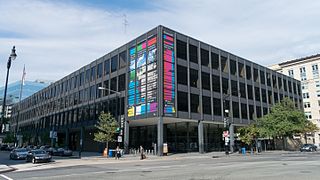
The Martin Luther King Jr. Memorial Library (MLKML) is the central facility of the District of Columbia Public Library (DCPL), it was constructed and named in honor of the American civil rights leader Dr. Martin Luther King Jr. It is located in the 901 G St. NW in Downtown Washington, D.C., with its main entrance between 9th and 10th St. in the opposite corner of Gallery Place station, and the Smithsonian American Art Museum. The library is located in and around the Chinatown, Mount Vernon Square, and Penn Quarter neighborhoods.

The House of the Temple is a Masonic temple in Washington, D.C., United States, that serves as the headquarters of the Scottish Rite of Freemasonry, Southern Jurisdiction, U.S.A.

Healy Hall is a National Historic Landmark and the flagship building of the main campus of Georgetown University in Washington, D.C., United States. Constructed between 1877 and 1879, the hall was designed by Paul J. Pelz and John L. Smithmeyer, both of whom also designed the Thomas Jefferson Building of the Library of Congress. The structure is named after Patrick Francis Healy, who was the President of Georgetown University at the time.

Waddy Butler Wood was an American architect of the early 20th century and resident of Washington, D.C. Although Wood designed and remodeled numerous private residences, his reputation rested primarily on his larger commissions, such as banks, commercial offices, and government buildings. His most notable works include the Woodrow Wilson House and the Main Interior Building.

The Detroit Masonic Temple is the world's largest Masonic Temple. Located in the Cass Corridor of Detroit, Michigan, at 500 Temple Street, the building serves as a home to various masonic organizations including the York Rite Sovereign College of North America. The building contains a variety of public spaces including three theaters, three ballrooms and banquet halls, and a 160 by 100 feet clear-span drill hall.
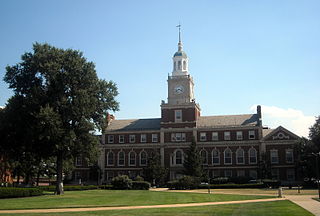
Albert Irvin Cassell (1895–1969) was a prominent mid-twentieth-century African-American architect in Washington, D.C., whose work shaped many academic communities in the United States. He designed buildings for Howard University in Washington D.C., Morgan State University in Baltimore, and Virginia Union University in Richmond. Cassell also designed and built civic structures for the State of Maryland and the District of Columbia.

Alumni Hall at the University of Pittsburgh is a Pittsburgh History and Landmarks Foundation Historic Landmark that was formerly known as the Masonic Temple in Pittsburgh. Constructed in 1914-1915, it was designed by renowned architect Benno Janssen of Janssen & Abbot Architects. Other buildings in Pittsburgh's Oakland Cultural District designed by Janssen include the Pittsburgh Athletic Association, Mellon Institute, and Pitt's Eberly Hall.

The L. Ron Hubbard House, also known as the Original Founding Church of Scientology, is a writer's house museum and former Scientology church located at 1812 19th Street NW in the Dupont Circle neighborhood of Washington, D.C., United States. Public tours are given on a regular basis. The operating Founding Church is now located at 1424 16th Street NW. After L. Ron Hubbard established Scientology in the 1950s the building housed offices of the Founding Church of Scientology and it is where he performed the first Scientology wedding. Hubbard's personal office was located in the building from 1956 to 1961.

The Sulgrave Club is a private women's club located at 1801 Massachusetts Avenue NW on the east side of Dupont Circle in Washington, D.C. The clubhouse is the former Beaux-Arts mansion on Embassy Row built for Herbert and Martha Blow Wadsworth and designed by noted architect George Cary. During World War I the Wadsworth House was used as the local headquarters for the American Red Cross.
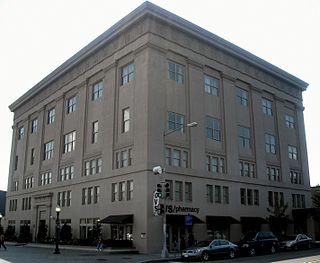
The Prince Hall Masonic Temple built in 1922 is an historic Prince Hall Masonic building located at 1000 U Street, NW in Washington, D.C. It is the headquarters of the Prince Hall Grand Lodge District of Columbia, and houses the MWPGM Roland D. Williams Center for Masonic Excellence. It is part of the Greater U Street Historic District.
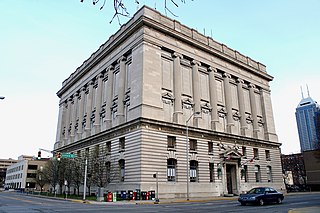
The current Indianapolis Masonic Temple, also known as Indiana Freemasons Hall, is a historic Masonic Temple located at Indianapolis, Indiana. Construction was begun in 1908, and the building was dedicated in May 1909. It is an eight-story, Classical Revival style cubic form building faced in Indiana limestone. The building features rows of engaged Ionic order columns. It was jointly financed by the Indianapolis Masonic Temple Association and the Grand Lodge of Free and Accepted Masons of Indiana, and was designed by the distinguished Indianapolis architectural firm of Rubush and Hunter.

The Heritage, formerly known as the Journal Record Building, Law Journal Record Building, Masonic Temple and the India Temple Shrine Building, is a Neoclassical building in Oklahoma City, Oklahoma. It was completed in 1923 and listed on the National Register of Historic Places in 1980. It was damaged in the 1995 Oklahoma City bombing. It houses the Oklahoma City National Memorial Museum in the western 1/3 of the building and The Heritage, a class A alternative office space, in the remaining portion of the building.

The Janney Elementary School is a public elementary school from Pre-K through 5th grade. A part of the District of Columbia Public Schools, it enrolls approximately 740 students.
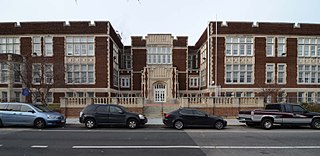
Bruce-Monroe Elementary School at Park View is a bilingual elementary school in Washington, D.C. Named after Blanche Bruce and James Monroe, it has been located in the historic Park View School in the city's Park View neighborhood since 2008. It is part of the District of Columbia Public Schools.
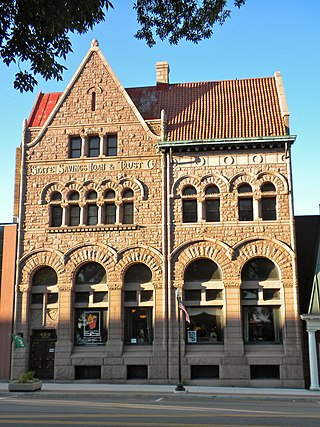
The Downtown Quincy Historic District is a historic district located in downtown Quincy, Illinois, containing numerous buildings showcasing some of the city's late 19th century and early 20th century architecture. In the 1800s, Quincy was a popular destination for travelers making their way west via rail service. The Mississippi River was also a major economic benefit for the community, furthering the city's importance in commerce.

The Georgetown Car Barn, historically known as the Capital Traction Company Union Station, is a building in the Georgetown neighborhood of Washington, D.C., in the United States. Designed by the architect Waddy Butler Wood, it was built between 1895 and 1897 by the Capital Traction Company as a union terminal for several Washington and Virginia streetcar lines. The adjacent Exorcist steps, later named after their appearance in William Friedkin's 1973 horror film The Exorcist, were built during the initial construction to connect M Street with Prospect Street.





















